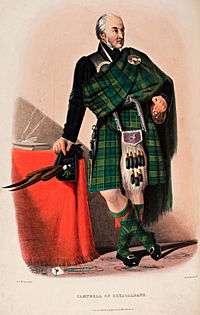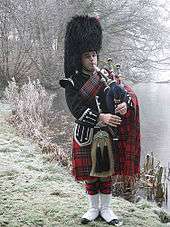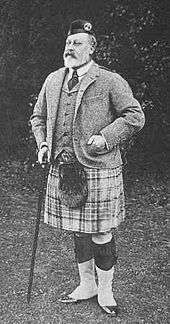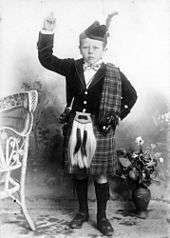Highland dress

The term highland dress describes the traditional, regional dress of the Highlands and Isles of Scotland. It is often characterised by tartan (plaid in North America) patterns in some form, including dress tartans which are modified versions which include white in place of a more prominent colour. Specific designs of shirt, jacket, bodice, and headwear may also be worn, along with clan badges and other devices indicating family and heritage.
Men's highland dress includes a kilt (or trews) of his clan tartan, along with either a tartan full plaid, fly plaid, or short belted plaid. Accessories may include a belt, sporran, sgian dubh, tartan socks, garters, kilt pins and clan badges. Ghillie brogues are the traditional, welted rand, thick soled shoes with no tongues and long laces. The laces are wrapped around and tied firmly above the wearer's ankles so that the shoes do not get pulled off in the mud. The shoes lack tongues so the wearer's feet can dry more quickly in the typically damp Scottish weather.
Women's highland dress is also based on the clan tartan, either that of her birth clan or, if married, that of her spouse's clan if she so chooses. Traditionally, women and girls do not wear kilts but may wear ankle-length tartan skirts, along with a colour-coordinated blouse and vest. A tartan earasaid, sash or tonnag (smaller shawl) may also be worn, usually pinned with a brooch, sometimes with a clan badge or other family or cultural motif. Women's shoes, also called ghillies, are more often the thin, foldable variety with sole and uppers cut from one piece of leather, now used mostly for indoor wear and dancing. Like the modern ghillie brogues, they also have no tongue, and the laces are wrapped around and tied above the wearer's ankles.
Historical descriptions


.jpg)
In 1618, a poet from London, John Taylor described the costume of Scottish aristocrats, lairds, and their followers and servants, dressed for hunting at Braemar. In August and September, all classes dressed in the same fashion by custom, as if equals. This included tartan stockings and jerkins, with garters of twisted straw, and a finer plaid mantle round their shoulders. They had knotted handkerchiefs at their necks and wore blue caps. Taylor said the tartan was "warm stuff of diverse colours."[1]

Near the end of the seventeenth century, Martin Martin gave a description of traditional women's clothing in the Western Islands, the earasaid with its brooches and buckles.
"The ancient dress wore by the women, and which is yet wore by some of the vulgar, called arisad, is a white plaid, having a few small stripes of black, blue and red; it reached from the neck to the heels, and was tied before on the breast with a buckle of silver or brass, according to the quality of the person. I have seen some of the former of an hundred marks value; it was broad as any ordinary pewter plate, the whole curiously engraven with various animals etc. There was a lesser buckle which was wore in the middle of the larger, and above two ounces weight; it had in the centre a large piece of crystal, or some finer stone, and this was set all around with several finer stones of a lesser size. The plaid being pleated all round, was tied with a belt below the breast; the belt was of leather, and several pieces of silver intermixed with the leather like a chain. The lower end of the belt has a piece of plate about eight inches long, and three in breadth, curiously engraven; the end of which was adorned with fine stones, or pieces of red coral. They wore sleeves of scarlet cloth, closed at the end as men's vests, with gold lace round them, having plate buttons with fine stones. The head dress was a fine kerchief of linen strait (tight) about the head, hanging down the back taper-wise; a large lock of hair hangs down their cheeks above their breast, the lower end tied with a knot of ribbands."[2]
According to the English military chaplain Thomas Morer, in 1689 Highland men wore plaids about seven or eight yards long, which covered from the neck to the knees except the right arm. Beneath the plaid they wore a waistcoat or a shirt to the same length as the drape of the plaid. These were "belted plaids." Their stockings were made of the same stuff as the plaid and their shoes were called "brocks" (brogues). Bonnets were blue or "sad" coloured. Morer noted that the fineness of the fabric varied according to the wealth and status of the man.
Scottish Lowlanders and Borderers were dressed much like the English, except both men and women also used a plaid as a cloak. The Lowland women wrapped their plaids over their heads as hoods,[3] whereas Lowland and Border men wore a checkered maud (plaid) wrapped about their upper body.[4] The maud, woven in a pattern known variously as Border tartan, Falkirk tartan, Shepherd's check, Shepherd's plaid[5] and Galashiels grey, became the identifying feature of Border dress as a result of the garment's mention by fashionable Border Scots such as Walter Scott, James Hogg and Henry Scott Riddell and their wearing of it in public.[6] Together with Robbie Burns, they can be seen wearing a maud in portraits, etchings and statues.
Modern Highland dress


(photograph by Allan Warren, 1984)
Day wear

- Plain or tweed Argyll-, Crail-, and Braemar-stylestyle jacket
- Belt and Buckle or Five-button waistcoat in matching, complementary or tartan material
- Kilt
- shirt with turndown collar
- long tie
- Black brogues
- Tartan, argyle, diced, or dark hose (white and off-white hose should be avoided)
- Flashes or garter ties
- Day or horse hair sporran
- Day Dress sgian dubh. Again less intricate than a full dress one, these are typically made of horn or antler.
Semi-formal dress
The semi-formal version of Highland dress consists of:[7][8]
- Black (or charcoal) semi-formal kilt jacket in superfine wool or barathea; Argyll-, Crail-, and Braemar-style jackets are suitable
- Five- or six-button waistcoat in black, grey, putty, or tartan
- Kilt
- White shirt with turndown collar, French cuffs, and cufflinks
- Tie in a single colour
- Black brogues
- Tartan, argyle, diced, or dark hose (white and off-white hose should be avoided)
- Flashes or garter ties
- Day Dress sporran. These have less intricate designs and are often black leather. However a full dress sporran is not considered inappropriate
- Day Dress sgian dubh. Again less intricate than a full dress one, these are typically made of horn or antler.
- Dirk
Black tie
.jpg)

Traditionally, black tie Scots Highland dress comprises:
- Black, or other solid colour, barathea jacket with silver buttons—Regulation Doublet, Prince Charlie (coatee), Brian Boru, Braemar, Argyll, and black mess jackets are suitable. There is some contention about whether the Duke of Montrose and Sheriffmuir doublets are too formal for black-tie occasions.
- Matching or tartan waistcoat
- Kilt
- White shirt with shirt studs, French or barrel cuffs, and a turndown collar (wing collars are reserved for white tie in most locales)
- Black bow tie or white lace jabot
- Evening dress brogues
- Full-dress kilt hose (diced or tartan) (Off-white hose are often seen but are deplored by some, such as the late David Lumsden of Cushnie[9])
- Silk flashes or garter ties
- Dress sporran with silver chain
- Black, silver-mounted Sgian dubh
- Dirk (optional)
- Highland bonnet with crest badge (only suitable out of doors)[10]
White tie
The traditional white-tie version of Highland dress consists of:
- Formal kilt doublet in barathea or velvet— the regulation doublet, Montrose doublet, Sheriffmuir doublet, and Kenmore doublet are suitable in a variety of colours. Velvet is considered to be a more formal material. The Prince Charlie (coatee) is considered to be less formal, although when introduced it was to be worn with a White lace jabot. Tartan jackets are also seen.
- Waistcoat in white marcella, tartan (usually to match the kilt), red, or the same material as the doublet; no waistcoat is worn with the Kenmore doublet or Montrose doublet
- Kilt with formal kilt pin
- White stiff-front shirt with wing collar and white, gold, or silver studs and cufflinks for the regulation doublet, or a white formal shirt and optional lace cuffs for the Montrose, Sheriffmuir, and Kenmore doublets
- White lace jabot; a black silk or white marcella bow tie may be worn in place of the jabot with the regulation doublet (highland wear often includes a black bow tie even at white-tie events)
- Black formal shoes or black buckle brogues
- Tartan or diced kilt hose
- Silk garter flashes or garter ties
- Silver-mounted sporran in fur, sealskin, or hair with a silver chain belt
- Black, silver-mounted, and jeweled sgian dubh
- Short belted plaid with silver plaid brooch (optional)
- Scottish dirk (optional)
- Highland bonnet with badge (only worn out of doors)[11]
Notes
- ↑ He is shown outfitted with a Capercaillie feathered Balmoral bonnet, Ancient Campbell Tartan belted plaid held with an amber Cairngorm gemstone brooch, dirk, sporran with silver Inverneill Campbell crest badge, sporran chains, thistle belt badge in silver, leather gloves, silver epaulettes, dress shirt, waisted Inverneill Campbell Crest Badge, Bonnie Prince Charlie jacket, silver kilt pin, Ancient Campbell Tartan kilt made from Traditional dyes of the Scottish Highlands, flintlock pistol and ceremonial sword.
- ↑ From top to bottom these are called, feather bonnet, doublet, plaid and plaid brooch, belt, sporran, kilt, hose tops, spats, brogues.
References
- ↑ Taylor, John, Early Prose & Poetical Works, London & Glasgow, (1888), pp.49-50
- ↑ Martin, Description of the Western Islands of Scotland, (1703), pp.208-209: quoted in Robertson, ed., Inventaires de la Royne Desscosse, Bannatyne Club, (1863) p.lxviii footnote.
- ↑ Hume Brown, P., Early Travellers in Scotland James Thin (1891 repr. 1978), 269-270, 272, quoting Morer, Thomas, A Short Account of Scotland (1715)
- ↑ Craig, A. (1837). Parish of Bedrule. New Statistical Account of Scotland (vol. 3). Edinburgh: Blackwood.
- ↑ The Scottish Register of Tartans. https://www.tartanregister.gov.uk/tartanDetails.aspx?ref=3781
- ↑ Moffat, A. (2015). Scotland: A history from the earliest times. Edinburgh: Birlinn.
- 1 2 "So that's how to wear your kilt". The Scotsman.
- 1 2 "What to Wear?". Scottish Tartan Authority.
- ↑ Published: 6:56PM BST 12 Sep 2008 (2008-09-12). "David Lumsden of Cushnie". Telegraph. Retrieved 2009-10-19.
- ↑ MacKinnon, C. R. (1970). Scottish Tartans & Highland Dress. Glasgow/London: Wm. Collins Sons & Co. Ltd. p. 98. ISBN 0-00-411114-1.
- ↑ MacKinnon, C. R. (1970). Scottish Tartans & Highland Dress. Glasgow/London: Wm. Collins Sons & Co. Ltd. p. 99. ISBN 0-00-411114-1.
External links
| Wikimedia Commons has media related to Highland dress. |
| Wikimedia Commons has media related to Tartans from the Vestiarium Scoticum. |
- The Scottish Tartans Authority - Registered Scottish Charity
- Martin Martin, A description of the Western Islands of Scotland, London (1703)
- Clans of the Scottish Highlands Fashion Plates from The Metropolitan Museum of Art Libraries
.jpg)